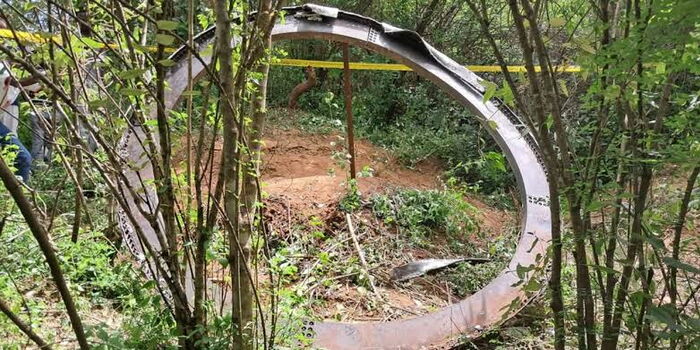Kenya could stand to gain billions should the country seek compensation for 500-kilogram rocket debris that fell at Mukuku village in eastern Makueni County on December 30, 2024, sparking suspicion.
While clarifying the object fell from space, the Kenya Space Agency (KSA) on January 3, 2025, distanced itself from claims that the government is demanding compensation from India for the space debris.
However, the Agency asserted the matter will be pursued through the laid-down channels as provided for under International Space Law.
One of the largest compensations in history was a fallen space object that occurred in 1960 when a Thor DM-21 rocket launched from Florida and exploded shortly after launch. Debris from this incident fell onto Cuba, resulting in the death of a cow named Rufina.
A photo collage of the metallic ring that fell from the skies and landed in Mukuku in Makueni County, on Monday, December 31, 2024.
KSA
The Cuban government demanded compensation from the US, which paid USD 2 million (equivalent to USD 21 million today adjusted after inflation, translating to Ksh2.7 billion).
What process would Kenya pursue if it seeks compensation from India?
The first step for Kenya is to launch a compensation process for damages caused by space debris. This would involve establishing a legal framework that governs liability and compensation related to space activities.
This framework could be based on existing international treaties, such as the Outer Space Treaty of 1967 and the Convention on Registration of Objects Launched into Outer Space. These treaties outline the responsibilities of states regarding space activities and provide guidelines for liability in case of damage caused by space objects.
Once a legal framework is in place, the next step would be to assess the extent of the damage caused by the debris. This assessment would involve a thorough investigation of the incident to determine the nature and extent of any damage caused by the falling debris.
Collecting evidence from affected residents, including photographs, witness statements, and any physical damage to property or livestock, would follow with an assessment of both physical damage and psychological impact on residents, which may include trauma or fear resulting from the incident.
After assessing the damage, the Kenya Space Agency would determine who is liable for compensation. This could involve identifying responsible parties where the debris originated.
Afterwards, KSA can engage with international bodies like the United Nations Office for Outer Space Affairs (UNOOSA) to clarify liability issues based on international law.
Once liability is established, calculating appropriate compensation amounts would be necessary. This could involve establishing compensation criteria based on property damage, loss of livestock, and emotional distress.
Experts like insurance professionals can be consulted to ensure fair compensation amounts are determined.
Finally, Kenya would need to establish a mechanism for disbursing compensation funds to affected residents by setting up a system where affected individuals can apply for compensation directly through local authorities or designated agencies.
Scientists at the Kenya Space Agency interact with the Latest Radio technology
Photo


